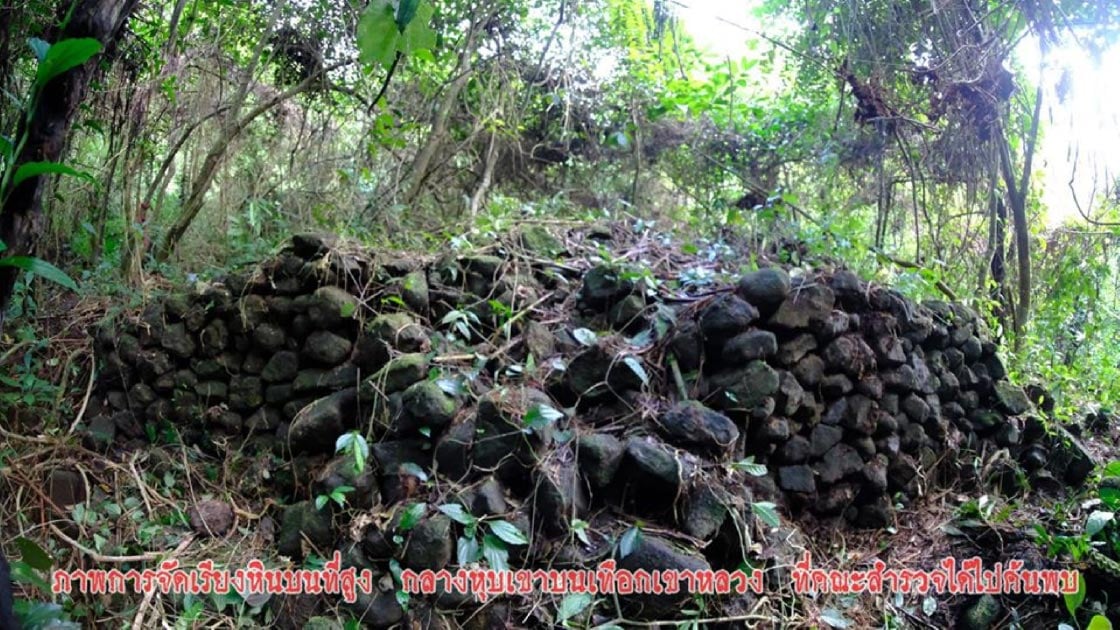Lost Mountain Temple Discovered in Thai Jungle
The discovery of an ancient stone built settlement that is thought to be potentially “thousands of years old” was announced on a Facebook post by historian Phum iradejwong, who stated that his team, which he called the “explorers of the City of Mountains”, made their discovery of “stone structures, relics and at least one phallus-shaped rock”, in the Nakhon Si Thammarat province.
Discovering the Lost Mountain Temple
Historian Phum said the new site shared construction features which he sees as similar to other ruins in the region which are dated to the 6th century BC. He said his team of explorers had first heard rumors of the ruined settlement in 2017, but only this month have they finally joined local experts who cut through dense jungle leading to the mountain platform where “several stone walls and heaps of rocks” were identified.

The rock structures share construction features found elsewhere in the region. Phum Chiradechwong
During the late-1st and early-2nd millennium BC, early peoples expanded in mainland Southeast Asia and by the Iron Age this area that was sandwiched between two oceans was an important link for the East-West maritime trade. Since at least 500 BC the region was a production hub of jewelry, tin and forest products and according to a report on Siam-Society, archaeologists believe the distribution of Bronze drums indicates that the isthmian tract was part of the neighborhood of communities around the Gulf of Siam. It was a recognized busy hub of trade and by the 13th century, Nakhon Si Thammarat, had become a mueang, or city state.
- ONE OF THE GREATEST MONUMENTS IN THE WORLD BUT WHO BUILT IT? THE STRANGE ORIGINS OF BOROBUDUR AND THE LOST WORLD OF CHAM
- THE LAGUNA COPPERPLATE INSCRIPTION: AN ANCIENT TEXT THAT CHANGED THE PERCEPTION OF THE HISTORY OF THE PHILIPPINES
- HOW TO RULE PEACEFULLY THROUGH TRADING: THE RISE AND FALL OF THE FORGOTTEN MARITIME EMPIRE, SRIVIJAYA
Does Phallic Worship Hold the Key?
Nakhon Si Thammarat is therefore one of the most ancient cities of Thailand, previously named the Kingdom of Ligor, and it contains hundreds of ruined buildings of historical significance. Archaeologists and historians know a king of Srivijaya established a foothold on the Malay Peninsular at Ligor by AD 775, where he built a sanctuary dedicated to the Buddha and to the Bodhisattvas Padmapani and Vajrapani.

Phallus-shaped rock found in the lost city location. (Phum Chiradechwong)
The actual ancient origins of the newly discovered settlement cannot yet be confirmed as Phum said in his statement that “only 5%” of the site has been explored, but he suggests the ruins might be contemporary with the Khao Ka Ancient Remains in Nakhon Si Thammarat which is one of the oldest and largest Hindu temples in southern Thailand.
And the reason he thinks the new site might be related to the culture who built the Khao Ka Hindu temples on a small hill in the 6th century AD, is because archaeologists at that site discovered large stone bowls and “Shiva Lingam” sockets, which match the phallic nature of worship performed at the new site, evident in his discovery of a giant stone penis.

The city and temple were discovered after tracking through thick jungle. (Phum Chiradechwong)
For Those Asian Adventurers Out There
In an article on Coconuts.co Phum’s team are said to have alerted park rangers and authorities including the governor of Nakhon Si Thammarat of their discovery, and he said that the site can only be dated after “thoroughly exploring this rainforest area”, and he cheekily added “ jai yen yen”, telling folk “to be patient” as they wait for forthcoming exciting news from the new site.
Thailand is renowned for its happy population, and if you have been there it is very clear why the country is often called the “Land of Smiles”, however, when asking for directions one must show caution as a right hand can often mean turn left, and a forward motion with a hand might mean reverse. Therefore, if you decide to build the Khao Kha Archaeological Site into a Thailand trip, please trust these directions, and stick to them.
The Khao Kha Archaeological Site is located in Ban Khao Kha, Moo 11 Saopao Subdistrict, Sichon District, Nakhon Si Thammarat. To travel safely to Khao Kha Archaeological Site: take Highway 401 (Asian Highway A 18) through Tha Sala District to Sichon Districta and when at Km. 99 turn left along the Pakdhaban road and you will arrive at Khao Kha about 4 km ahead.
Top image: Lost temple found in Thai jungle. Source: Phum Chiradechwong
By Ashley Cowie



















